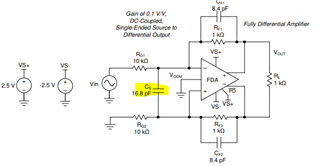Other Parts Discussed in Thread: THS4131, , THS4551, ADS9224R
Hello,
I considering AD conversion circuit that circuit is used ADS8422 and THS4131.
I considering this circuit based on figure 29 of ADS8422 data sheet.
Input voltage range of this circuit is +10V to -10V and sampling rate is 3MHz.
I want to confirm that there is no problem with the circuit changes shown below.
I would be happy if you could tell me anything wrong with the circuit operation.
<Point of change>
1. Change the resistance combination to 2200 ohm and 390 ohm to get a gain of 0.18 for THS4131.
2. Connect +10V/-10V input signal to +VIN of figure 29.
3. Connect GND(0V) to -VIN of figure 29.
4. Add 560pF capacitor parallel with each 390 ohm resistors. (700kHz anti-aliasing filter for sampling rate 3MHz)
5. Supply +5V power and -5V power to THS4131.
6. Supply +5V power to ADS8422.
Regards,
MESH


